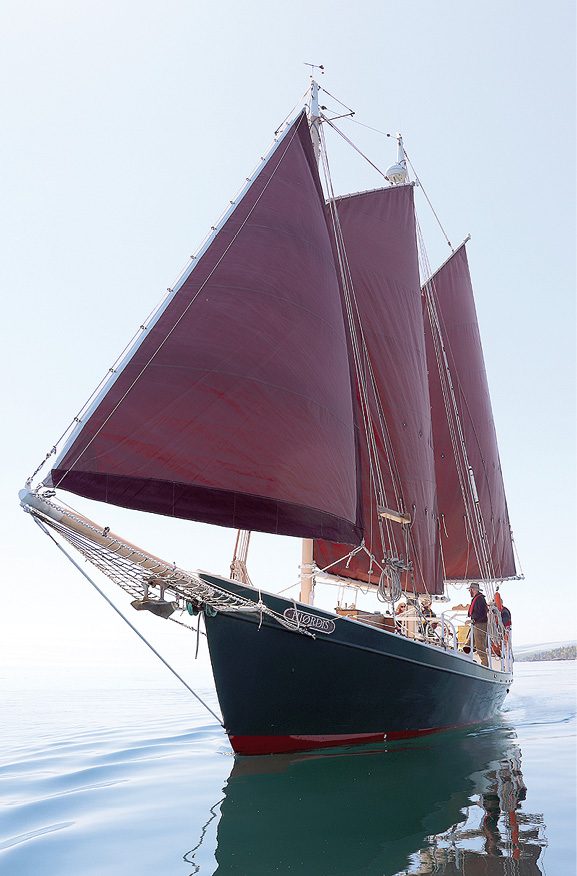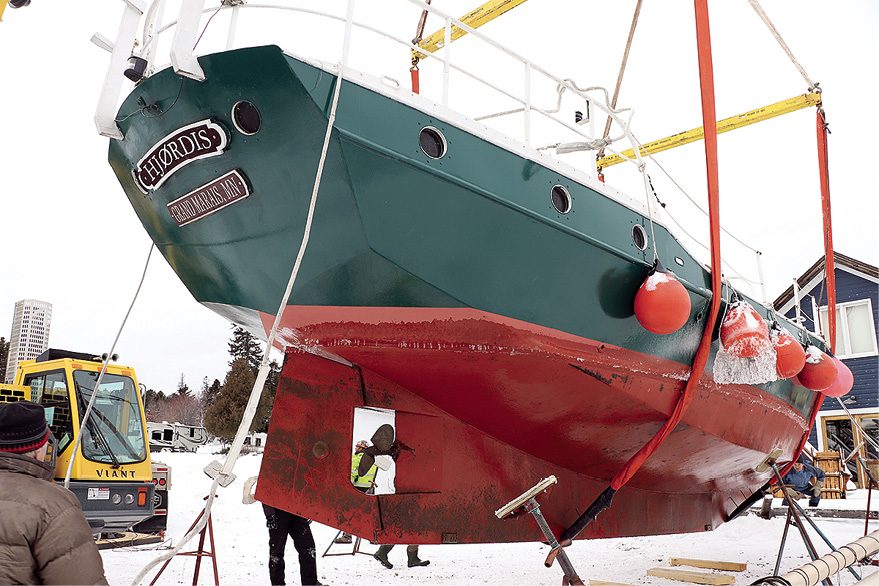The day before Christmas Eve, Matthew Brown was eating fish and chips at Fisherman’s Daughter Restaurant in Grand Marais. He looked out of the restaurant window at Hjørdis—the beloved sailing schooner and unofficial flagship of the harbor—at her winter berth. Something didn’t look right; she was riding low in the water. Very low. A life-long sailor and founder of the sailing program at North House Folk School, he would know. He ran over to the school store at North House and alerted Cindy Hansen, the only North House staff member working that day.
Hjørdis was built in the 1970s by Ken Woodward of Detroit Michigan. According to an article in The Daily Mining Gazette dated August 25, 1979, the build took Ken 6,000 hours over seven years working in his backyard. His day job was as a machinist for General Motors, so he knew how to work metal: the boat is constructed of corten steel and is based on the Thomas Colvin “Gazelle” design. He named it Hjørdis after his mother and launched it in June of 1979. Legend has it Ken and his wife cruised in the Bahamas for 10 years before selling the boat in Florida.

Randy Ellestad of Knife River bought the boat in 1990 and hauled it over-land the 1,700 miles to Lake Superior. He rerigged the boat to a gaff schooner, and it eventually ended up on the docks at the fledgling North House Folk School. Seeing an opportunity, North House purchased the vessel with the intent of providing daily sails and educational trips to destinations around the Lake, including the Apostle Islands, Isle Royale and the Slates, with Matthew Brown at the helm. Over the years, the vessel has taken out 1,000s of passengers and served as a platform for adult and youth sail training.
Hjørdis’ home port of Grand Marais lacks the infrastructure for hauling large boats. Hjørdis’ steel construction allows us to keep her in the water for a year or two at a time, while underwater aerators prevent ice damage to the hull. Every third year we run it down to Knife River where they have a lift with the capacity to haul the 10-ton vessel. Our system has worked for years. Until this winter.
When I reached the docks on December 23rd, Hjørdis was riding at least three feet lower in the water than usual. I opened the hatch and found the main salon submerged, and the few items we had left in the boat floating around like rubber ducks in a bathtub. The diesel inboard and battery bank were completely underwater. Brown, current Hjørdis captain Bill Hansen, and I bought every electric sump pump we could find to start draining the water, but it wasn’t enough until we sourced a gas powered “trash pump” from local contractor Anton Moody. At 150 gallons per minute, we (mostly) dried it out. There was an audible trickle coming in from an invisible set of pin holes under a seal in the aft bilge. The onboard bilge pump must have either failed or been incapable of keeping up. With the help of Mark Gordon of Amicus Adventure Sailing and friend Matt Morris, we had a temporary fix by midnight and had a space heater and backup pump with a float switch rigged up. Merry Christmas.
Without a local haul-out facility, I called Superior-based Viant Crane and they ran up with a 110-ton crane and lifted Hjørdis out of the water less than a week later. (The crane got stuck in the Grand Marais Recreation Area Campground, but that’s a story for another day…) While she’s been out of the water, we hand-cranked the water out of the cylinders, successfully fired up the engine, and gave the boat some additional upgrades. The masts got a fresh new paint job and we hosted a class that covered the traditional mast hoops in leather. Costs associated with the haul-out and repair were generously underwritten by grants from the Pachel Foundation and Carl and Verna Schmidt Foundation.
As this article goes to print, we’re putting the finishing touches on bottom paint and mast repairs. Eric Schultz from Electroforge Welding in Two Harbors did a professional repair on the compromised stern-tube, and Hjørdisshould be back in service by early June, more seaworthy than ever. Next Christmas, trim the tree and wrap your presents, but mind the bilge too.
Matt Nesheim is the facilities director at North House Folk School, where traditional craft is taught on the shore of Lake Superior.

